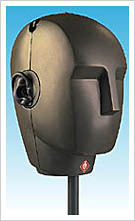BSLF | A Senior Capstone Project by Dan Hauer

About BSLF
Anyone who has ever attended a live music event knows that nothing compares to the real thing. That is, even the best stereo recording of the event will fall far short of the experience of actually being there. One reason for this is the inability to record and playback audio whilst maintaining a realistic soundstage. Typical loudspeaker arrangements are simply unable to reproduce this 3D soundstage due in large part to the inherent mixing of the left and right channels in a room. Recording known as binaural recordings are an excellent, yet scarcely employed, solution to reproduce the soundstage present when witnessing a live event. Binaural recordings are typically made with a special dummy head, known as a binaural head, outfitted with small omnidirectional microphones located in the realistically shaped ears. (See photo at left of a Neumann KU-100 binaural head.) When live events are recorded with these special microphones, and subsequently played back through headphones, the original 3D soundstage of the live experience is preserved nearly flawlessly. Binaural recordings are not compatible with loudspeakers due to the aforementioned channel mixing.
This project will use binaural concepts to spatially filter two binaural or stereo source signals. Using Matlab, perceived sound intensities will be graphed on a 2D surface relative to the listener's position. This will be achieved by detecting correlations in the source signals and comparing them to data experimentally gathered using a binaural head. In this way, the software will emulate the sound localization ability of the human brain. Secondly, the software will have the ability to decode an arbitrary number of signals from the original two signals that would correspond to ranges of the azimuth angle of the sound source relative to the listener. That is, each signal corresponds to a range of azimuth angles and will only contain sound information that is perceived to originate from the chosen direction. Both of these functionalities could be tested using a similar setup used in the acquisition of the correlation data, but the position of sound source would be unknown, and it would up to the software to localize the sound.
Many applications of this software exist. One such application would involve a remedy to a previously mentioned problem. By filtering a stereo recording spatially the software could create an array of independent signals based on source angles. If these signals were sent to a properly arranged array of loudspeakers (meaning a hemispherical arrangement with loudspeakers receiving a signal that corresponds spatially to their azimuth angle in relation to the listener), the result would be a much improved and realistic soundstage as compared with a conventional two speaker (left and right) configuration. Another application involves using these techniques to record an audio event with an array of microphones (not necessarily in a dummy head arrangement). This would provide the recorder the ability to filter out offending or unwanted sounds based on the sounds origin. For instance, if a ceiling tile vibrates sympathetically to low bass tones (as is often the case in the Bradley University Student Center ballroom), the unwanted noise from the tile(s) can be filtered from a recording made in the room based on the spatial location. In this case, an array of microphones may be arranged vertically, and any sound whose source is determined to be above a certain angle (i.e. from the ceiling) can be eliminated from the recording without any loss of sound from the intended recording subject.